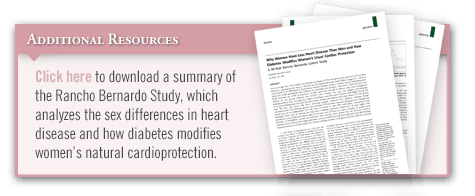Nearly half of all adults with diabetes in the United States are women, and the risk of cardiovascular disease (CVD)—the most common complication of diabetes—is more serious among women than men. Recent reports suggest that gender disparities exist in terms of access to care and receipt of preventive services (Table 1). Among people with diabetes who have had a heart attack, women have lower survival rates and a poorer quality of life than men. “It’s important to identify women with diabetes and those at high risk for the disease so that we can provide the necessary interventions to improve outcomes,” says Elizabeth Barrett-Connor, MD, FACP, FAHA. Early interventions and access to preventive care services are important for reducing diabetes risk as well as risks for developing other diseases, most importantly CVD.
A Paucity of Data on CVD & Women
About 40 years ago, few cohort studies of CVD included women, and fewer still included diabetes or glycemia as risk factors. In 1985, a review of hyperglycemia as a risk factor for coronary heart disease (CHD) was published. It included 29 prospective studies of glycemia and heart disease risk, adjusting for cholesterol, smoking, and blood pressure. It found an independent association between hyperglycemia and CHD in five of 13 cohort studies. Glycemia was not associated with CVD outcomes in studies using fasting plasma glucose or casual glucose levels.
“Alarmingly, only four of these 29 studies included women,” says Dr. Barrett-Connor. “Another study, published in 1999, reviewed glucose and incident cardiovascular events, but of the 20 studies that were analyzed, only two included women. These large analyses highlight the fact that women have historically been poorly represented in clinical research. We still need more information about women and diabetes.”
The Rancho Bernardo Study
The Rancho Bernardo Study (RBS) was launched in the early 1970s in an effort to understand how diabetes impacts risk of CHD in both sexes as well as the role of obesity and other CVD risk factors. Dr. Barrett-Connor, who was one of many epidemiologists who conducted the investigation, notes that the RBS began as one of 12 Lipid Research Clinic (LRC) Prevalence Study sites. “Our facility in San Diego was the only North American LRC site that measured height, weight, blood pressure, and fasting plasma glucose,” she says. “We also added 11 questions about lifestyle, medical history, family history, classic CVD risk factors, and diabetes history.”
Dr. Barrett-Connor says that, over 40 years, the RBS provided many new insights and highlighted remaining gaps for understanding how diabetes eradicates women’s usual cardioprotection. “Several important themes emerged,” she says (Table 2). “The majority of deaths in adults with diabetes result from accelerated CVD. The increasing incidence of obesity in the U.S. and elsewhere suggests that diabetes is expected to increase the burden of macrovascular cardiovascular and microvascular complications and costs to patients and society.”
Findings from the RBS and other analyses will foster new research in the future, Dr. Barrett-Connor says. “We need to look deeper into mid-life biology and biomarkers that may be reversible before, during, or after menopause, and may prevent or delay CHD. To get these answers, we need well-characterized studies with extended follow-up. Studies such as the RBS will continue to provide training and discovery opportunities.”
Increasing Awareness to Reduce CVD Risks
Clinicians should be vigilant about diagnosing women with diabetes early and concentrate their efforts on strategies to reduce risks of CVD. “We’re gathering more information on the distinct differences between men and women with regard to CVD,” says Dr. Barrett-Connor. “Current studies already have shown us that there are no sex differences in blood pressure, stroke, and peripheral arterial disease, except those explained by different tobacco use patterns. Unfortunately, the management of diabetic women who have CVD continues to vary.”
Studies have shown that most lifestyle modifications are equally beneficial for both men and women, a finding Dr. Barrett-Connor says is important. “Women often have the same diabetes risk factors as men. They’re likely to benefit from the same diet, exercise, and smoking cessa-tion interventions we currently use in men. However, studies show that women are less likely than men to receive certain medications, most notably statins. This must be addressed in order to overcome disparities in care.”
Pregnancy Considerations on CVD Risk
Dr. Barrett-Connor notes that women with diabetes must also plan childbearing carefully. “It’s especially important to keep blood glucose levels as near to normal as possible before and during pregnancy so that we can protect the mother and baby. Pregnancy itself may alter insulin levels and affect diabetes-related eye and kidney problems. Polycystic ovary disease is common and can also have prognostic effects on CVD risk. Paying more attention to diabetes, weight gain, and CVD risk factors in pregnant women is paramount.”



